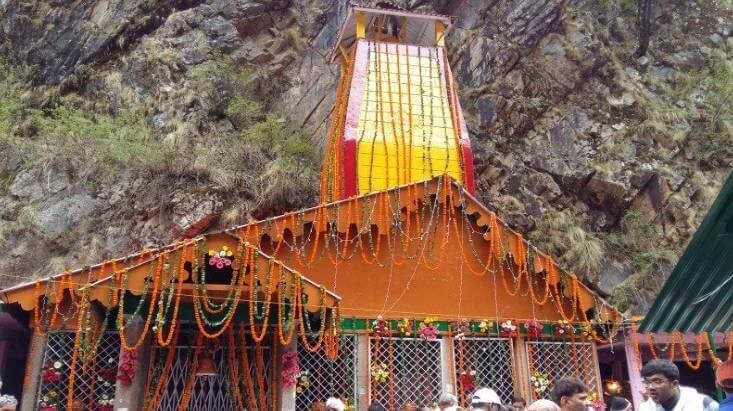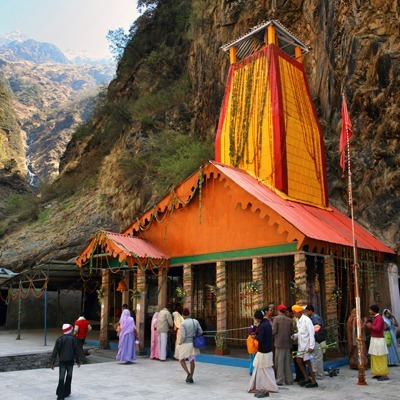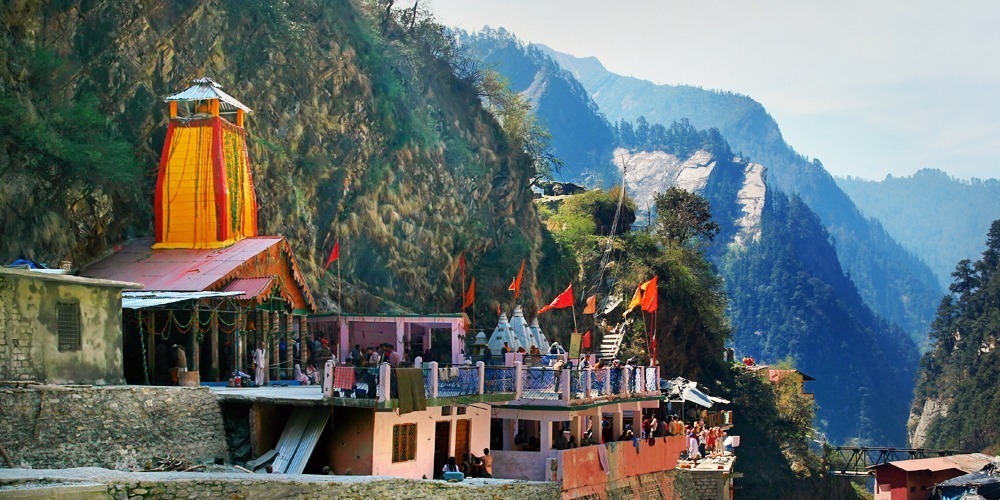
Yamunotri Temple, Uttarakhand
Yamunotri Temple is situated in the western region of Garhwal Himalayas at an altitude of 3,235 metres near the river source. The temple was built in 1839 by Sundarshan Shah who was the king of the cultural center of Tehri. There was a small shrine at the site prior to the construction of the temple.
Historical background and Architectural splendor
Yamunotri, located in the Uttarkashi district of Uttarakhand, is one of the Char Dham pilgrimage sites dedicated to Goddess Yamuna. The temple has a rich historical background, believed to have been constructed by Maharani Guleria of Jaipur in the 19th century. However, it has undergone renovations and reconstructions over the years.
The Yamunotri Temple exhibits traditional Himalayan architecture with a distinctive red-colored facade, intricate wood carvings, and a conical-shaped shikara (spire). The temple is situated amidst stunning natural surroundings, and the Yamuna River flows in close proximity to the shrine.Pilgrims approach the temple through a picturesque trek, and the journey itself is a part of the spiritual experience.Adjacent to the Yamunotri Temple is the Surya Kund, a hot water spring, where pilgrims cook rice and potatoes tied in cloth. The cooked prasad is then offered to the deity. Divya Shila, a rock pillar near the Surya Kund, is worshiped before entering the temple

Religious Significance
It is one of the Char Dhams, a sacred pilgrimage circuit that holds immense importance in Hindu tradition. The primary attraction is the Yamunotri Temple, dedicated to Goddess Yamuna, the personification of the Yamuna River. According to Hindu mythology, Yamunotri is believed to be the source of the Yamuna River and is associated with the legendary sage Asit Muni. Pilgrims embark on the challenging journey to Yamunotri to seek the goddess's blessings and perform rituals at the temple. The sacred Yamuna is considered the sister of Lord Yama, the god of death, and a dip in its icy waters is thought to purify the soul and absolve sins. The pilgrimage to Yamunotri is not only a physical journey but also a spiritual one, symbolizing devotion and the pursuit of divine blessings. The religious rituals performed at the temple, including the aarti and the Yamuna Pooja, contribute to the spiritual sanctity of the site.

Festival and Celebrations
Here the festivals celebrated are Yamunotri Temple Opening and Closing Ceremonies, Akshaya Tritiya, Yamuna Jayanti, Choti Diwali, Navratri, Yamunotri Temple Aarti, Yamuna Saptami and Yamuna Snan. Participating in these festivals and celebrations here adds a festive and devotional dimension to the pilgrimage experience,.
Surroundings area & attractions
- Surya Kund: A hot water spring near the Yamunotri Temple where pilgrims traditionally cook rice and potatoes tied in cloth. The cooked prasad is then offered to the deity.
- Divya Shila: A rock pillar near Surya Kund that is worshiped by pilgrims before entering the Yamunotri Temple. It is considered an auspicious ritual.
- Hanuman Chatti: The base for the trek to Yamunotri, Hanuman Chatti is a picturesque town with scenic landscapes. It serves as a starting point for the Char Dham Yatra.
FAQ
The Yamunotri Temple is located in the town of Yamunotri in the Uttarkashi district of Uttarakhand, India.
The presiding deity of the Yamunotri Temple is Goddess Yamuna, the divine goddess of the sacred river Yamuna.
The Yamunotri Temple is one of the Char Dham pilgrimage sites in India and holds great significance for Hindu devotees. It is believed to be the source of the Yamuna River, which is considered holy in Hindu mythology.
The Yamunotri Temple has ancient origins and is believed to have been built by Maharaja Pratap Shah of Tehri Garhwal in the 19th century. It underwent renovation and restoration over the years, with the current temple structure dating back to the 20th century.
The main rituals and ceremonies at the Yamunotri Temple include the morning and evening aarti (worship with lamps), abhishekam (ritual bathing of the deity), and special prayers offered to Goddess Yamuna by priests and devotees.
Yes, the Yamuna Kund is a natural thermal spring located near the Yamunotri Temple. It is considered sacred by devotees, who take a holy dip in its waters before entering the temple premises.
Yes, visitors and pilgrims can take a dip in the icy-cold waters of the Yamuna River near the Yamunotri Temple. It is believed that bathing in the holy waters of the Yamuna cleanses one’s sins and bestows spiritual merit.
Yes, there are several nearby attractions and trekking routes for visitors near the Yamunotri Temple, including the Surya Kund, Divya Shila, and trekking routes to the Kharsali Village and Hanuman Chatti.
The best time to visit Yamunotri Temple is during the summer months from May to June and the early autumn months of September to October when the weather is pleasant and the temple is accessible.
Yamunotri Temple can be reached by road from major cities like Dehradun and Rishikesh. The nearest airport is Jolly Grant Airport in Dehradun, and the nearest railway station is in Rishikesh. From there, one can hire a taxi or take a bus to Yamunotri.
The Divya Shila is a sacred rock pillar located near the Yamunotri Temple. It is believed to be a divine manifestation and is worshipped by devotees before entering the temple premises.
According to Hindu mythology, Goddess Yamuna is the sister of Lord Yama, the god of death. It is believed that bathing in the waters of the Yamuna River near the Yamunotri Temple can cleanse one’s sins and grant liberation from the cycle of birth and death.
The trekking routes near the Yamunotri Temple offer scenic views of the Himalayan landscape and lead to nearby attractions such as Surya Kund and Kharsali Village. These treks are popular among adventure enthusiasts and pilgrims seeking spiritual solace.
Yes, visitors to the Yamunotri Temple may have the opportunity to witness special festivals and rituals celebrated with great fervor, including the Yamuna Jayanti festival, which marks the birth anniversary of Goddess Yamuna.
There are various accommodation options available for pilgrims near the Yamunotri Temple, including guesthouses, dharamshalas (pilgrims’ rest houses), and tents/huts managed by local authorities. Pilgrims can choose accommodation based on their budget and preferences.
While there is no strict dress code, visitors are encouraged to dress modestly and respectfully while visiting the Yamunotri Temple. It is advisable to wear warm clothing, especially during the colder months, and comfortable footwear suitable for walking.
Visitors trekking to the Yamunotri Temple should ensure they are physically fit and acclimatized to the high altitude. It is advisable to carry sufficient water, snacks, and emergency supplies, as well as to follow safety guidelines provided by local authorities.
Photography is generally allowed inside the Yamunotri Temple premises, but in some places
sacred rituals or areas where photography is prohibited.
The local authorities and temple administration undertake various initiatives to maintain cleanliness and preserve the natural environment surrounding the Yamunotri Temple, including waste management programs and afforestation efforts.
Yes, there are shops and stalls near the Yamunotri Temple where visitors can purchase prasad, garlands, idols, souvenirs, religious items, and offerings for worship.
Visitor information
Entry Fee: No fee
Timings :
- 6.00 AM to 8.00 PM
Darshan Days- Open April/May to October/November
Address:
Yamunotri, Yamnotri Range, Uttarakhand 249141
Notable Events and Incidents
- Opening and Closing Ceremonies
- Yamunotri Yatra Commencement
- Gangotri-Yamunotri Yatra Route Restoration
- Kedarnath Floods Impact
- Yamunotri Temple Winter Closure
Connectivity :
- By Road: Accessible by road from major towns in Uttarakhand.Shared taxis, buses, and private vehicles are common modes of transportation.
- By Air: The nearest airport is Jolly Grant Airport in Dehradun, approximately 210 kilometers away.Taxis and buses are available from the airport to reach the base for Yamunotri.
- By Rail: The nearest railway station is Rishikesh, around 200 kilometers away. Taxis and buses connect Rishikesh to the starting point of the Yamunotri trek.
- Yamunotri Trek: The pilgrimage involves a trek of approximately 6 kilometers from Hanuman Chatti to Yamunotri. Ponies and palanquins are available for those who prefer assisted travel.
- Local Transport: Within Yamunotri, walking is the primary mode of local transport. The temple and surrounding attractions are accessible by foot.
- Char Dham Yatra Route: Yamunotri is a crucial destination in the Char Dham Yatra pilgrimage circuit, along with Gangotri, Kedarnath, and Badrinath. Pilgrims often undertake the entire Char Dham Yatra as a sacred journey.
- Road Conditions: The road leading to the starting point of the trek may be challenging, especially during the monsoon season. Pilgrims are advised to check road conditions before planning their journey.
- Yamunotri Base Camps: Base camps such as Hanuman Chatti and Janki Chatti serve as starting points for the trek to Yamunotri. Accommodations and facilities for pilgrims are available at these base camps.
